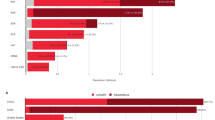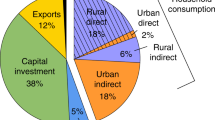Abstract
Air pollution is a major threat to health and the dangers are particularly acute in low- and middle-income countries where levels of exposure tend to be high and adaptation resources are often limited. However, little is known about how the burden of pollution is spread across different income groups within these countries. Understanding who is impacted by air pollution is important for designing equitable policy solutions. In this study, we used data providing high-resolution wealth estimates for more than 100 countries, combined with high-resolution estimates of air pollution, to estimate how wealth is correlated with ambient air pollution in low- and middle-income countries around the world. We found that within countries, on average, air pollution is positively correlated with wealth, but the relationship is highly heterogeneous across countries. Countries with primarily anthropogenic sources of air pollution seem to have the strongest positive correlations between pollution and wealth. The fact that air pollution and wealth are both disproportionately high in urban areas where economic activity is largely concentrated seems to drive this relationship. The spatial correlation between pollution and areas of economic opportunity highlights the urgent need to develop policies that reduce air pollution to promote more equitable economic growth.
This is a preview of subscription content, access via your institution
Access options
Access Nature and 54 other Nature Portfolio journals
Get Nature+, our best-value online-access subscription
$29.99 / 30 days
cancel any time
Subscribe to this journal
Receive 12 digital issues and online access to articles
$119.00 per year
only $9.92 per issue
Buy this article
- Purchase on Springer Link
- Instant access to full article PDF
Prices may be subject to local taxes which are calculated during checkout




Similar content being viewed by others
Data availability
All of the raw data used in this study are publicly available, with links to the original data sources provided in the Methods or following list: RWI data: https://data.humdata.org/dataset/relative-wealth-index?; EDGAR data: https://edgar.jrc.ec.europa.eu/; URCA data: https://data.apps.fao.org/catalog/iso/9dc31512-a438-4b59-acfd-72830fbd6943; pollution data: https://sites.wustl.edu/acag/datasets/surface-pm2-5/; elevation data: https://terra.nasa.gov/data/aster-data; GHSL data: https://ghsl.jrc.ec.europa.eu/. Data to replicate the findings of this study are available via the Harvard Dataverse at https://doi.org/10.7910/DVN/IPFXGF.
Code availability
The code to replicate the results is available via the Harvard Dataverse at https://doi.org/10.7910/DVN/IPFXGF.
References
Weichenthal, S. et al. How low can you go? Air pollution affects mortality at very low levels. Sci. Adv. 8, eabo3381 (2022).
Shaddick, G., Thomas, M., Mudu, P., Ruggeri, G. & Gumy, S. Half the world’s population are exposed to increasing air pollution. npj Clim. Atmos. Sci. 3, 23 (2020).
Fuller, R. et al. Pollution and health: a progress update. Lancet Planet. Health 6, E535–E547 (2022).
Richardson, E. A., Pearce, J., Tunstall, H., Mitchell, R. & Shortt, N. K. Particulate air pollution and health inequalities: a europe-wide ecological analysis. Int. J. Health Geogr. 12, 34 (2013).
Tessum, C. W. et al. PM2.5 polluters disproportionately and systemically affect people of color in the United States. Sci. Adv. 7, eabf4491 (2021).
Mohai, P., Pellow, D. & Roberts, J. T. Environmental justice. Annu. Rev. Environ. Resour. 34, 405–430 (2009).
Clark, L. P., Millet, D. B. & Marshall, J. D. Changes in transportation-related air pollution exposures by race-ethnicity and socioeconomic status: outdoor nitrogen dioxide in the United States in 2000 and 2010. Environ. Health Perspect. 125, 097012 (2017).
Mikati, I., Benson, A. F., Luben, T. J., Sacks, J. D. & Richmond-Bryant, J. Disparities in distribution of particulate matter emission sources by race and poverty status. Am. J. Public Health 108, 480–485 (2018).
Jbaily, A. et al. Air pollution exposure disparities across US population and income groups. Nature 601, 228–233 (2022).
Bell, M. L. & Ebisu, K. Environmental inequality in exposures to airborne particulate matter components in the United States. Environ. Health Perspect. 120, 1699–1704 (2012).
Miranda, M. L., Edwards, S. E., Keating, M. H. & Paul, C. J. Making the environmental justice grade: the relative burden of air pollution exposure in the United States. Int. J. Environ. Res. Public Health 8, 1755–1771 (2011).
Banzhaf, S., Ma, L. & Timmins, C. Environmental justice: the economics of race, place, and pollution. J. Econ. Perspect. 33, 185–208 (2019).
Liu, J. et al. Disparities in air pollution exposure in the United States by race/ethnicity and income, 1990–2010. Environ. Health Perspect. 129, 127005 (2021).
Colmer, J., Hardman, I., Shimshack, J. & Voorheis, J. Disparities in PM2.5 air pollution in the United States. Science 369, 575–578 (2020).
Rosofsky, A., Levy, J. I., Zanobetti, A., Janulewicz, P. & Fabian, M. P. Temporal trends in air pollution exposure inequality in Massachusetts. Environ. Res. 161, 76–86 (2018).
Baden, B. M., Noonan, D. S. & Turaga, R. M. R. Scales of justice: is there a geographic bias in environmental equity analysis? J. Environ. Plan. Manag. 50, 163–185 (2007).
Hajat, A., Hsia, C. & O’Neill, M. S. Socioeconomic disparities and air pollution exposure: a global review. Curr. Environ. Health Rep. 2, 440–450 (2015).
Wang, Y., Wang, Y., Xu, H., Zhao, Y. & Marshall, J. D. Ambient air pollution and socioeconomic status in China. Environ. Health Perspect. 130, 067001 (2022).
Gupta, S., Das, S. & Murty, M. Quantifying air pollution vulnerability and its distributional consequences: some perspectives from Delhi. Ecol. Econ. Soc. 2, 93–125 (2019).
Dasgupta, S., Lall, S. V. & Wheeler, D. Traffic, Air Pollution, and Distributional Impacts in Dar es Salaam: A Spatial Analysis with New Satellite Data. Policy Research Working Paper 9185 (World Bank, 2020).
Dionisio, K. L. et al. Air pollution in Accra neighborhoods: spatial, socioeconomic, and temporal patterns. Env. Sci. Tech. 44, 2270–2276 (2010).
Rooney, M. S. et al. Spatial and temporal patterns of particulate matter sources and pollution in four communities in Accra, Ghana. Sci. Total Environ. 435, 107–114 (2012).
Liu, Q., Wang, S., Zhang, W., Li, J. & Dong, G. The effect of natural and anthropogenic factors on PM2.5: empirical evidence from Chinese cities with different income levels. Sci. Total Environ. 653, 157–167 (2019).
Wu, J.-X., He, L.-Y. & Zhang, Z. On the co-evolution of PM2.5 concentrations and income in China: a joint distribution dynamics approach. Energy Econ. 105, 105706 (2022).
Xu, Y. et al. Unraveling environmental justice in ambient PM2.5 exposure in Beijing: a big data approach. Comput. Environ. Urban Syst. 75, 12–21 (2019).
Glaeser, E. Triumph of the City: How Our Greatest Invention Makes Us Richer, Smarter, Greener, Healthier, and Happier (Penguin, 2012).
Chi, G., Fang, H., Chatterjee, S. & Blumenstock, J. E. Microestimates of wealth for all low- and middle-income countries. Proc. Natl Acad. Sci. USA 119, e2113658119 (2022).
Coker, E. S. et al. The effects of air pollution on COVID-19 related mortality in northern Italy. Environ. Resour. Econ. 76, 611–634 (2020).
Ji, X., Yao, Y. & Long, X. What causes PM2.5 pollution? Cross-economy empirical analysis from socioeconomic perspective. Energy Policy 119, 458–472 (2018).
Li, G., Fang, C., Wang, S. & Sun, S. The effect of economic growth, urbanization, and industrialization on fine particulate matter (PM2.5) concentrations in China. Environ. Sci. Technol. 50, 11452–11459 (2016).
Van Donkelaar, A., Martin, R. V., Li, C. & Burnett, R. T. Regional estimates of chemical composition of fine particulate matter using a combined geoscience–statistical method with information from satellites, models, and monitors. Environ. Sci. Technol. 53, 2595–2611 (2019).
Evans, M. J. et al. Policy-relevant findings from the DACCIWA project. Zenodo https://doi.org/10.5281/zenodo.1476843 (2018).
Toure, N. O. et al. Observed and modeled seasonal air quality and respiratory health in Senegal during 2015 and 2016. GeoHealth 3, 423–442 (2019).
Dobson, M. J. Contours of death: disease, mortality and the environment in early modern England. Health Transit. Rev. 2, 77–95 (1992).
Lim, S. et al. Comparing human exposure to fine particulate matter in low- and high-income countries: a systematic review of studies measuring personal PM2.5 exposure. Sci. Total Environ. 833, 155207 (2022).
Rao, N. D., Kiesewetter, G., Min, J., Pachauri, S. & Wagner, F. Household contributions to and impacts from air pollution in India. Nat. Sustain. 4, 859–867 (2021).
Burke, M. et al. Exposures and Behavioral Responses to Wildfire Smoke. Technical Report WP29380 (National Bureau of Economic Research, 2021).
Behrer, A., Park, R., Wagner, G., Golja, C. & Keith, D. Heat has larger impacts on labor in poorer areas. Environ. Res. Commun. 3, 095001 (2021).
Khan, K. & Calder, C. A. Restricted spatial regression methods: implications for inference. J. Am. Stat. Assoc. 117, 482–494 (2022).
Dechezleprêtre, A., Rivers, N. & Stadler, B. The economic cost of air pollution: evidence from Europe. OECD Working Paper 1584 (OECD, 2019).
Rutstein, S. O. & Johnson, K. DHS Comparative Reports 6: The DHS Wealth Index (DHS, ORC Macro, 2004).
Cattaneo, A., Nelson, A. & McMenomy, T. Global mapping of urban–rural catchment areas reveals unequal access to services. Proc. Natl Acad. Sci. USA 118, e2011990118 (2021).
Acknowledgements
We thank G. Englander, B. de la Cuesta, members of ECHOLab at Stanford and participants in the 2022 TWEEDS workshop for useful comments. The findings, interpretations and conclusions expressed in this paper are entirely those of the authors. They do not necessarily represent the views of the World Bank and its affiliated organizations, or those of the Executive Directors of the World Bank or the governments they represent.
Author information
Authors and Affiliations
Contributions
A.P.B. and S.H.-N. jointly designed the study, collected the data, conducted the analysis and wrote the paper.
Corresponding author
Ethics declarations
Competing interests
The authors declare no competing interests.
Peer review
Peer review information
Nature Sustainability thanks Yuhan Huang and the other, anonymous, reviewer(s) for their contribution to the peer review of this work.
Additional information
Publisher’s note Springer Nature remains neutral with regard to jurisdictional claims in published maps and institutional affiliations.
Supplementary information
Supplementary Information
Supplementary text, Figs. 1–21 and Tables 1–5.
Rights and permissions
Springer Nature or its licensor (e.g. a society or other partner) holds exclusive rights to this article under a publishing agreement with the author(s) or other rightsholder(s); author self-archiving of the accepted manuscript version of this article is solely governed by the terms of such publishing agreement and applicable law.
About this article
Cite this article
Behrer, A.P., Heft-Neal, S. Higher air pollution in wealthy districts of most low- and middle-income countries. Nat Sustain 7, 203–212 (2024). https://doi.org/10.1038/s41893-023-01254-x
Received:
Accepted:
Published:
Issue Date:
DOI: https://doi.org/10.1038/s41893-023-01254-x



